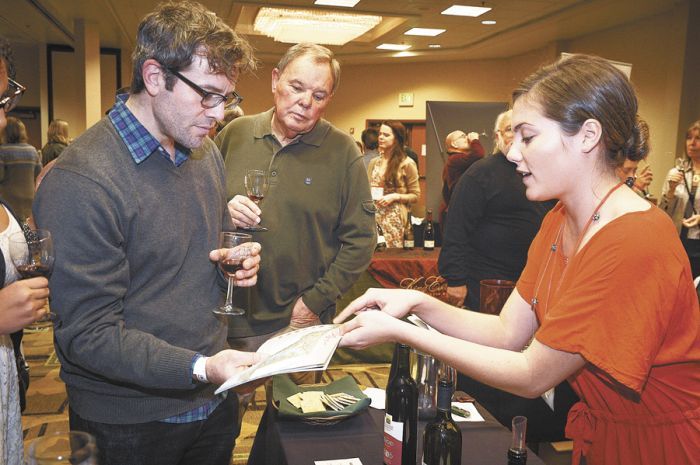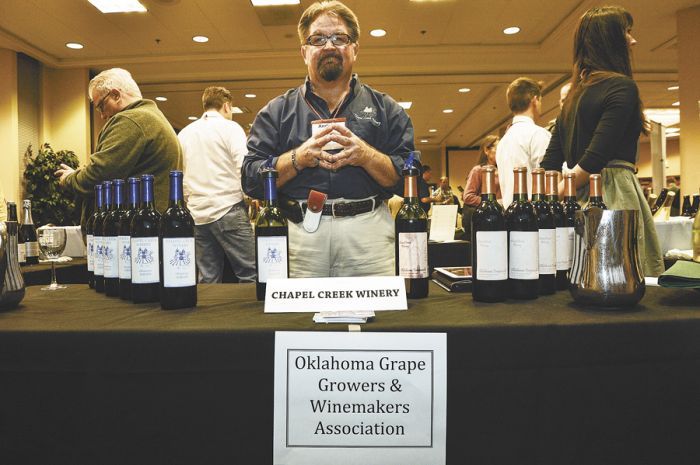Domestics on Tap


By Mark Stock
In conjunction with this year’s annual Wine Tourism Conference — Nov. 13–15 in Portland — representatives from wineries around the country poured their wares during the Great American Wine Festival, Nov. 16.
The gathering featured members of organizations, such as the Idaho Wine Commission and Maryland Wineries Association, offering samples of wines produced in their respective regions. Obscure viticultural states like Oklahoma shared the room with notable up-and-comers like Virginia and established powerhouses like California, Washington and Oregon.
It was an enlightening experience for many of the 300 attendees at the DoubleTree Hotel in Portland. The Great American Wine Fest unveiled wines from places most people can’t imagine produce wine; Oklahoma, for example, with its oppressive summer heat and propensity for severe storms. Yet, the Sooner State manages to produce a handful of varieties, including Norton and Tempranillo, both on display at the festival. These wines are the work of Chapel Creek Winery, an educational cellar based at Redlands Community College in El Reno, Okla.
Education was very much a theme here. Several labels were set at either viticulture and enology schools or winemaking cooperatives, like Oregon’s Carlton Winemakers Studio. Additionally, association members set out to use the festival as a podium, alerting tasters of their specific region’s growing industry. And while the caliber of wines ranged as widely as the states represented, the Great American Wine Fest succeeded in shedding light on relatively foreign producers.
Where the festival fell short was in its execution. Few winemakers or label representatives were present to answer questions about the wines; instead, tour association members poured from a small family of wines made by member labels. The spectrum was interesting; however, technical details about the wines themselves were lacking. The festival was somewhat of an afterthought, the main event being the preceding conference in which attendees shared info and strategies for marketing wine country in the broad sense.
In addition to the aforementioned states, the festival also played host to reps from Colorado and Missouri. The former boasts two American Viticultural Areas —Grand Valley and West Elks AVAs — and the highest elevation vineyards in North America, cresting 7,000 feet. The latter brings some 150 years of tradition and about a dozen planted recognized varietals. A trip through Missouri wine country might involve tasting anything from Chardonel to Vidal Blanc to St. Vincent, a hybrid red grape.
Arguably the most talked about winegrowing region east of the Mississippi since the Finger Lakes is Virginia. Thomas Jefferson tried his hand at viticulture at Monticello in the early 19th century, turning the nation’s interest toward the possibility of wine in the state of Virginia. Today, the state hosts well over 200 wineries, 25 designated wine trails and seven AVAs. Chardonnay, Riesling, Petit Verdot and Cab Franc, among others, thrive in the foothills of Appalachia and the Blue Ridge Mountains. The number of Virginia wineries has about doubled over the last eight years, and it is estimated that the industry has an annual effect on the state economy somewhere around $775 million.
Notable wines on display included the 2007 Lorenzino Reserve from Basignani in Maryland. A blend of Cab Sauvignon, Cab Franc and Merlot, this wine was nothing like your typical Bordeaux blend. Instead, it offered a healthy amount of earth and intriguing, savory notes reminiscent of tomato leaves. While a little syrupy, the Chardonel from Stone Hill in Missouri was interesting, too. Chardonnay’s heavier cousin, Chardonel, was established in the ’50s in the lab at Cornell University. This particular one was aged on the lees, offering additional structure to compete with the heavy oak usage.
Not surprisingly, a few Oregon groups and labels were present. The Willamette Valley Wineries Association and Southern Oregon Wineries Association were on hand. Left Coast Cellars, King Estate and newcomer Noel Family Vineyard joined the group. Unfortunately, members from the Finger Lakes, Ohio and Ontario, Canada, were not present to pour, as advertised. The Great American Wine Festival partnered with the Northwest Food & Wine Festival, a larger, more raucous event at the other end of the hotel.
For a first-time event, the Great American Wine Festival did offer an unusual view of lesser-known wine terrain outside the West Coast. Tradespeople were genuinely excited about their respective slice of the country’s ever-growing wine pie, however big or small that slice was.
With a few years under its belt — and presumably some much-needed winery representation — the festival could turn into something truly memorable. In the meantime, though, it’s a pleasant reminder that wine paints this country in broad strokes, from California to Connecticut, and then some.












